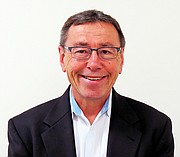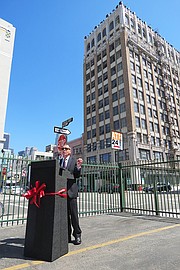MANUFACTURING
Kent Smith Stepping Down as Head of Los Angeles Fashion District BID
During his first days in 1999 as head of the Los Angeles Fashion District, Kent Smith remembers getting a call one Monday morning from his operations coordinator informing him there had been “a BBQ” in the district over the weekend.
“I didn’t realize that BBQ was code for someone being set on fire in their car,” he recalled inside his offices on the eleventh floor of the California Market Center.
Seventeen years later, crime has dropped and more people walk the streets to shop and dine. The word “BBQ” now has a different meaning.
With a major improvement in the neighborhood since he took over, Smith is stepping down this summer as the executive director of the Los Angeles Fashion District Business Improvement District—formed in 1996 as the first business improvement district in Los Angeles. Now eight BIDs blanket downtown Los Angeles, and another 26 span the Greater Los Angeles area.
Smith said he feels it’s a good time to leave because there have been so many improvements to the area and a host of projects scheduled to come on line in the next few years.
He doesn’t have a new job lined up yet but does want to spend more time with his wife of three years, Dr. Lori Shoemaker, who lives in Palo Alto, Calif., and is a research scientist at Stanford University. “I feel I have a third career in me,” he said.
An ad hoc committee is starting the search for a new BID chief executive.
Before arriving in Los Angeles, Smith, a Canadian, worked for 14 years with The Forks, a development company in Winnipeg. With a master’s degree in environmental design from the University of Calgary, Smith worked as the company’s chief executive and president to develop 70 acres of land that once had been a railway yard at the confluence of the Red River and the Assiniboine River in the dilapidated downtown area of the Canadian city.
The redevelopment project built a children’s museum, stage and concert area, open plaza, marina, walkway along the river, 117-room boutique hotel, 1,000 residential units, and 200,000 square feet of retail. It is now Winnipeg’s No. 1 tourist attraction.
Later, at a meeting of the International Downtown Association in Phoenix, Smith met Steven Gibson, now head of the Figueroa Corridor Business Improvement District in Los Angeles, who urged the urban planner and developer to apply for the top position at the LA Fashion District BID.
Smith had been to Los Angeles as a tourist and considered downtown Los Angeles—filled with buildings from the 1920s and 1930s—a diamond in the rough. “I could see the bones of a phenomenal set of neighborhoods were here, but it just wasn’t happening. With a little bit of love and work, I knew it could,” he recalled. He got the job.
A fashion city
When Smith started, there were only 56 blocks and 300 business owners who were part of the BID. Now the BID encompasses 100 blocks and 1,000 business owners. The annual budget has gone from $1.5 million to $4.6 million.
It also covers collecting more than 6 tons of trash a day, painting out 24,000 graffiti tags a year and fielding 50,000 calls on an annual basis. There are 42 part-time people on the clean team and 24 safety officers who work 24 hours a day, seven days a week. In addition, there are seven staff members. “We are like a little city here,” Smith said.
One of the first projects Smith worked on was helping pass the city’s Adaptive Reuse Ordinance, which allowed old buildings that had been establishments such as banks, office buildings, manufacturing centers or warehouses to be converted into residential units. The 1999 ordinance started in downtown Los Angeles and then spread to other local neighborhoods.
That led the way for projects such as Santee Court—a collection of nine contiguous historic industrial buildings that once had housed manufacturing companies. The structures, between Seventh and Eighth streets, were converted by businessman and developer Mark Weinstein into 550 residential units that opened in 2004 and paved the way for more residential conversions along Main and Los Angeles streets.
Another early residential conversion project was the Orpheum Lofts on Broadway. They sit over the 1926 Orpheum Theatre, owned by Steve Needleman and Anjac Fashion Buildings. Now lofts and apartments have sprung up all over the Fashion District as well as other historic neighborhoods in Los Angeles. Where once there were 10,000 residents in downtown Los Angeles, there are now 50,000.
“I knew what residential development could do,” Smith said, noting that he and Carol Schatz, chief executive and president of the Central City Association of Los Angeles, believed that bringing residents to downtown would give the area an economic boost and lead to more nighttime entertainment. “Before, trying to find a restaurant that was open at night in downtown was hard,” Smith said. “Now, downtown LA is a dining destination.”
The Fashion District saw its first hotel opening two years ago with the conversion of the ornate 1927 United Artists building on Broadway into the upscale Ace Hotel. Now three more hotels are slated to debut. The Tuck, a small 14-room hotel in a one-time warehouse and brothel at 820 S. Spring St., is scheduled to open its doors at the end of the summer.
The former Case Hotel—a mid-1920s structure at 1106 S. Broadway that later became the YWCA Job Training Corps building—is being converted into a boutique hotel called the Downtown LA Proper Hotel.
And not far away at 1060 S. Broadway, the former Los Angeles Railway Building is being transformed into a branch of the Hoxton hotel chain.
Brand-new apartment projects are popping up all over the place. Apartment developer Geoff Palmer is erecting two enormous buildings encompassing more than 680 apartments sitting between the Ace Hotel and the California Market Center.
All of this wouldn’t have been possible if it weren’t for the original goal of the Fashion District BID, which was to make the area clean and safe. Collecting garbage, putting out trash cans, having a safe team patrol on bicycle during the day and in cars at night have helped lower the crime rate by more than 50 percent in recent years and made people feel safer walking on the streets. “Ninety percent of our budget is spent on the public realm,” Smith said.
That has kept building owners and businesses happy. “He has been invaluable to us,” said Ethan Eller, who was on the Fashion District BID board from 2000 to 2006 and is property manager of The New Mart, a former manufacturing building built in 1926 now filled with nearly 100 high-end showrooms. “In the beginning it was all about safe and clean. The thing he expanded the most was if people don’t know about it, it hasn’t achieved anything.”
Eller said Smith got the word out to the public about all the opportunities available for shopping, dining and viewing historical buildings, plus posting valuable information on the BID’s website, which includes a detailed map of the area and instructions on how to get to the area.
Ilse Metchek, president of the California Fashion Association and former owner of clothing company Ilse M, described Smith as unflappable.
“He inherited a beehive of negative activity. It was the wholesalers versus the retailers [meaning the buildings who housed showrooms versus the buildings who housed retailers]. The two sides really had two different marketing strategies,” she said. “That, in essence, was the problem. There was always a fight about budgets and where they were going to spend their money and how they were going to spend their money. … He had the most diverse constituents that I’ve ever seen, with different agendas, different cultural backgrounds and truly different budgetary requirements—and he did a fabulous job.”
Brad Luster, a BID board member and president of Major Properties, which has two buildings in the Fashion District, said Smith has had the task of working with divisive factions that encompass 1,000 building owners.
“As owners, we all have our own agendas and selfish designs for what the BID should do and how the money should be spent,” he said. “At the end of the day, he got everybody to cooperate. That’s hats off for working for 17 years for a few thousand different bosses.”
























